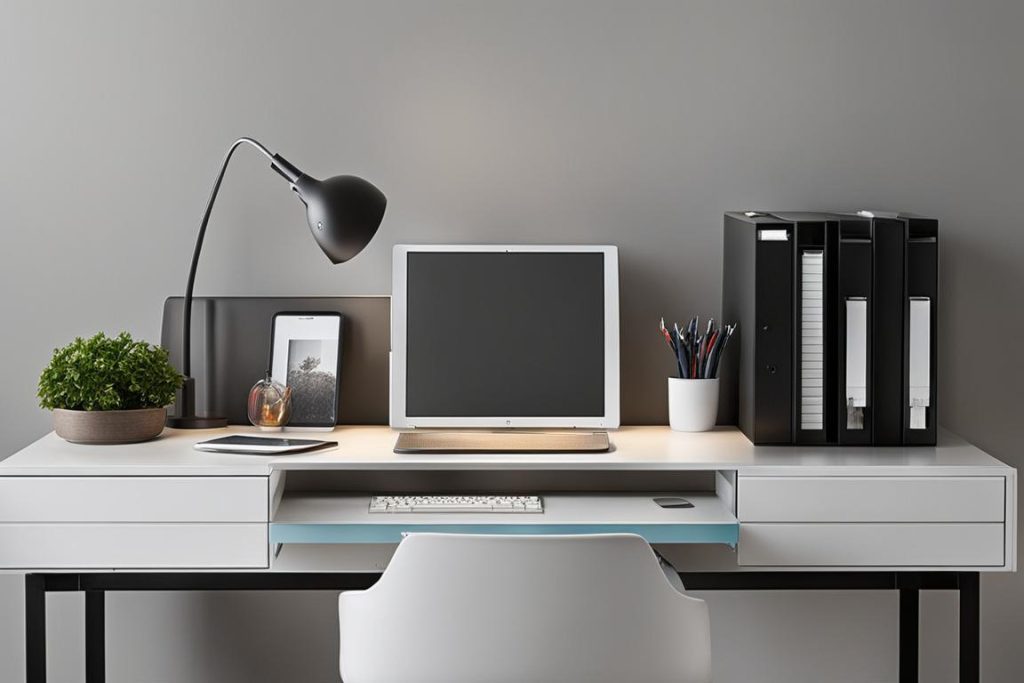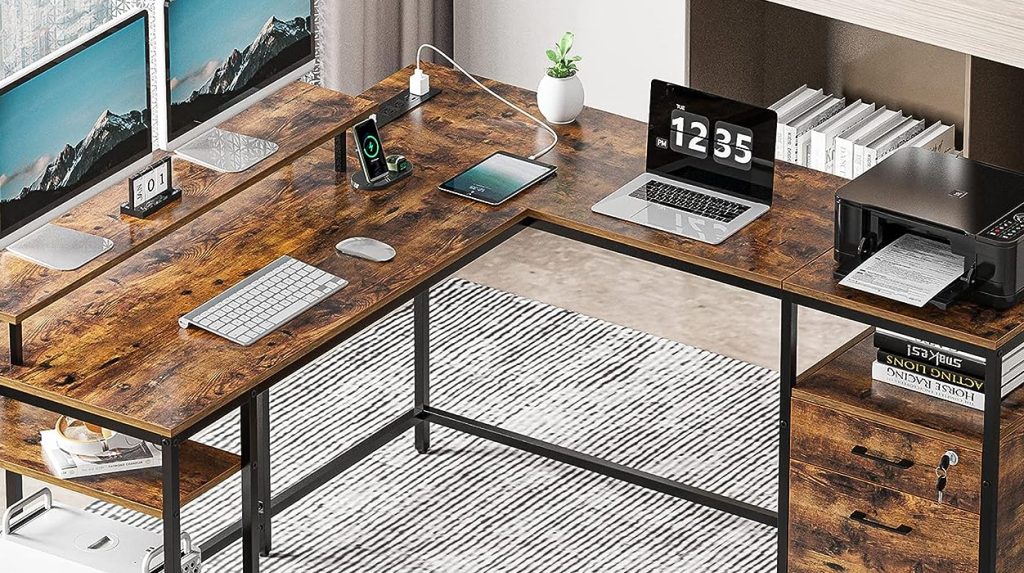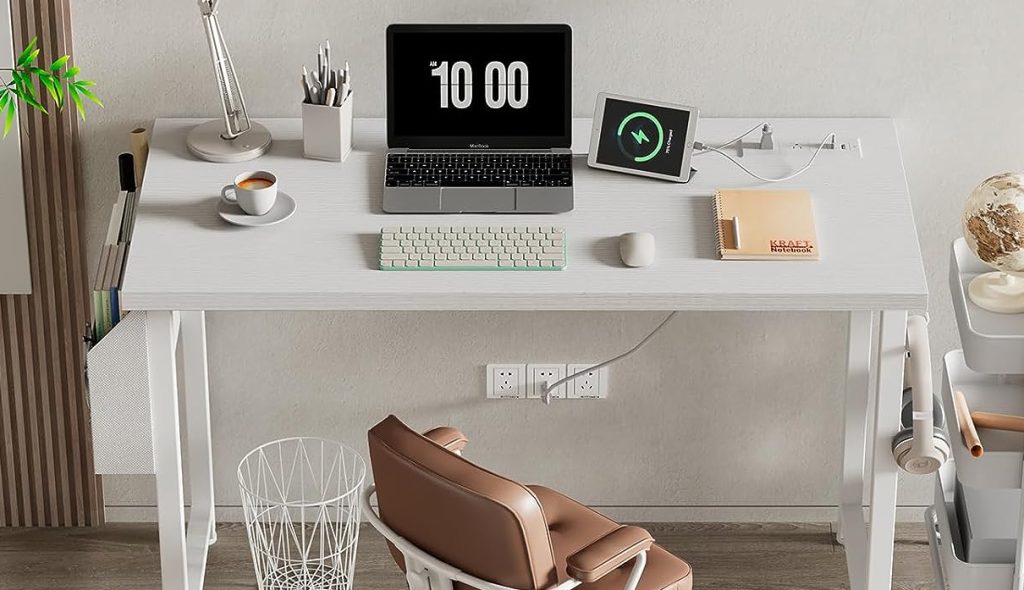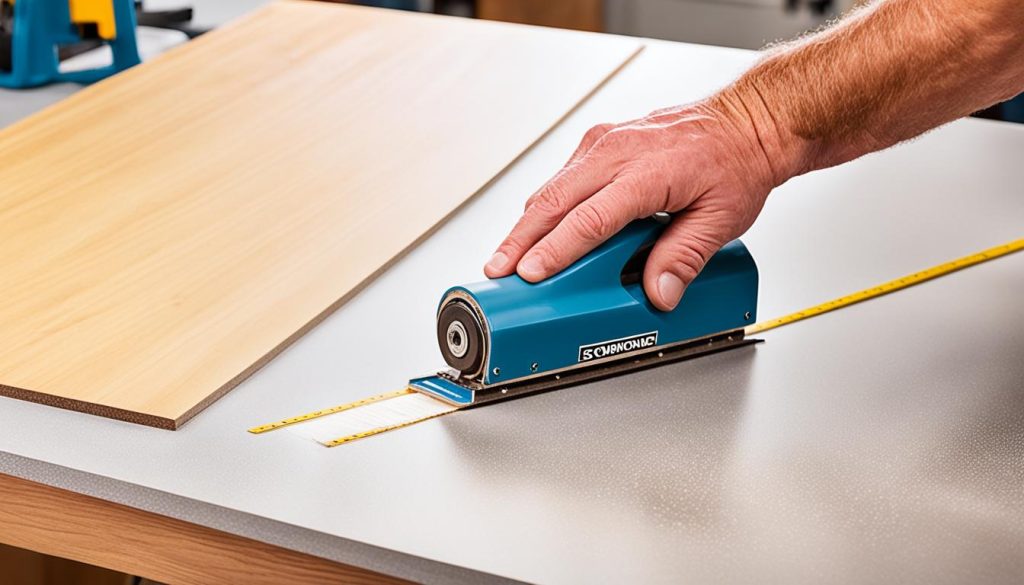Understanding office ergonomics and setting up your workspace properly can have a significant impact on your overall well-being and productivity. By following a few simple steps, you can create an ergonomic desk setup that promotes good posture and minimizes strain on your body.
Proper desk ergonomics involve considering factors such as chair height, desk height, keyboard position, monitor placement, and more. By optimizing these elements, you can reduce the risk of back pain, neck strain, and other musculoskeletal issues commonly associated with prolonged desk work.
So, how do you set up your desk for good posture? Let’s dive into the details:
How to Set Up Desk for Good Posture
- Choose a chair that supports your spine and adjust its height for optimal comfort.
- Create an optimal desk setup by ensuring enough leg and footroom and using ergonomic accessories.
- Position your keyboard and mouse correctly to maintain proper wrist alignment.
- Set up your monitor at eye level to reduce strain on your neck and eyes.
- Address common desk setup issues like laptop ergonomics and phone placement.
Choose a Chair That Supports Your Spine
When it comes to maintaining good posture at your desk, choosing the right chair is essential. A chair that supports your spine can greatly reduce the risk of back, neck, and shoulder pain. Here are some desk posture tips to consider:
- Chair Height: It’s important to adjust the height of your chair so that your feet rest flat on the floor. This helps you maintain proper alignment and prevents unnecessary strain on your lower back.
- Armrests: Position the armrests at a height that allows your arms to sit gently on them, with your elbows close to your body. This helps relieve tension in your shoulders and promotes a relaxed posture.
- Chair Adjustment: Be sure to fully utilize the adjustable features of your chair, such as the backrest angle, lumbar support, and seat depth. Experiment with different settings to find the most comfortable and supportive position for your body.
By selecting a chair that provides optimal support and making proper adjustments, you can significantly improve your office desk ergonomics and reduce the risk of discomfort or injury. Remember, maintaining good posture is key to staying comfortable and productive throughout the day.
Next, I’ll guide you on how to create an optimal desk setup to further enhance your posture and overall well-being. Stay tuned!
Create an Optimal Desk Setup
When it comes to setting up your desk for optimal comfort and productivity, there are several key factors to consider. Here are some tips to help you create a desk setup that minimizes back pain, maximizes desk height, provides ample leg and footroom, and includes essential desk accessories.
1. Clear Leg and Footroom
First and foremost, ensure that your desk has enough space for your legs and feet. Avoid storing items underneath your desk that may limit movement or restrict proper positioning. By keeping the area beneath your desk clear, you can enjoy unrestricted legroom and comfortably position your feet.
2. Adjusting Desk Height
The height of your desk plays a crucial role in maintaining proper posture and preventing back pain. Adjust the desk height so that it is at a comfortable level for you. Ideally, your elbows should rest at a 90-degree angle when typing, and your feet should be flat on the floor. If necessary, use footrests or sturdy boards to raise or lower the desk to your desired height.
3. Ergonomic Accessories
Incorporating ergonomic accessories into your desk setup can further enhance comfort and reduce strain on your body. Consider using wrist rests to provide support and alleviate pressure on your wrists during long hours of typing. You can also opt for desks with padded edges to minimize discomfort caused by leaning on the desk’s surface.
To create an ergonomically friendly workspace, invest in proper desk accessories such as an adjustable monitor stand to achieve optimal viewing height and reduce neck strain. Ensure that your monitor is positioned at eye level, about an arm’s length away, and tilted slightly downwards to reduce eye strain.


By following these desk setup tips, you can create an environment that promotes good posture, minimizes back pain, and enhances your overall work experience. Remember to take breaks, stretch periodically, and make adjustments as needed to maintain a comfortable and ergonomic workspace.
Position Your Keyboard and Mouse Correctly
When it comes to setting up your desk for optimal comfort and productivity, the position of your keyboard and mouse plays a crucial role. By following a few simple guidelines, you can ensure that your computer peripherals are ergonomically positioned, promoting wrist alignment and minimizing the risk of discomfort or injury.
Keyboard Placement
Place your keyboard directly in front of you, ensuring that your wrists and forearms are in line with each other. This alignment helps to maintain a neutral wrist position, reducing strain and potential discomfort. Additionally, position the keyboard at a height where your shoulders can remain relaxed throughout your workday. Remember, keeping your upper arms close to your body can further enhance your ergonomic setup.
Mouse Placement
Your mouse should be positioned within easy reach on the same surface as your keyboard. This placement allows for a seamless transition between typing and using the mouse, minimizing unnecessary strain on your arm and shoulder muscles. Remember to keep your wrists straight and your hands at or slightly below the level of your elbows while using the mouse. This positioning promotes a neutral wrist posture and reduces the risk of developing repetitive strain injuries.
By properly positioning your keyboard and mouse, you can create an optimal desk setup that supports your comfort and productivity. Remember to take regular breaks, stretch, and engage in healthy habits to maintain good posture throughout your workday. With these simple adjustments, you can significantly improve your overall well-being during long hours at your desk.
Set Up Your Monitor for Proper Viewing
When it comes to maintaining good desk posture ergonomics, proper computer monitor placement is essential. Follow these tips to optimize eye level, monitor distance, and reduce strain on your neck and eyes.
Positioning the Monitor
To start, place your computer monitor directly in front of you. This ensures that your neck and spine are aligned, reducing the risk of strain. Position the monitor about an arm’s length away from you, allowing for a comfortable viewing distance.
Eye Level Placement
It’s important to position the monitor at or slightly below eye level. This helps prevent neck and eye strain. You can achieve the right height by adjusting the monitor stand or using a monitor riser. Ensure that your gaze is naturally directed towards the center of the screen.
Avoiding Glare
Glare can cause eye discomfort and strain. Adjust the angle of your monitor to minimize glare from overhead lighting or windows. Choose a location where the screen won’t reflect bright lights or direct sunlight.
Bifocal Users
If you wear bifocals, it’s recommended to lower the monitor an additional 1 to 2 inches for better visibility. This allows you to see the screen without straining your neck or eyes.
By setting up your monitor in the correct position, you can improve your desk posture ergonomics and minimize the risk of discomfort and strain. Remember to take breaks and practice stretching exercises to further reduce the strain on your body during long sessions at your desk.


Addressing Common Desk Setup Issues
When it comes to creating an ergonomic desk setup, there are a few common issues that often come up. In this section, we’ll explore some solutions for laptop users, the placement of frequently used objects, phone placement, and the importance of taking breaks and stretching.
Laptop Ergonomics
If you primarily use a laptop for work, it’s important to consider the ergonomics of your setup. Using a laptop stand can help elevate the screen to eye level, reducing strain on your neck and promoting better posture. Additionally, invest in an external keyboard and mouse to ensure proper alignment of your wrists and avoid overextension.
Frequently Used Objects
Having frequently used objects within reach can save you from unnecessary stretching and straining. Take a moment to assess your workspace and arrange the objects you use most often within arm’s reach. This way, you can avoid awkward movements and reduce the risk of muscle tension or discomfort.
Phone Placement
Using a headset or speakerphone is recommended to avoid cradling the phone between your head and neck, which can strain your muscles and lead to discomfort. By keeping your hands and neck free, you can maintain better posture and prevent unnecessary strain.
Breaks and Stretches
Remember to take regular breaks throughout the day to give your body a chance to rest and recover. Stretching is also essential in preventing muscle stiffness and promoting blood circulation. Incorporate simple stretches, such as shoulder rolls or neck stretches, into your break routine to alleviate tension and improve your overall well-being.
By addressing these common desk setup issues, you can optimize your workspace for better ergonomics, reduce the risk of discomfort, and enhance your overall work experience.
Conclusion
Creating an ergonomic workstation setup and maintaining optimal desk posture are essential for your overall well-being and productivity. By following the ergonomic guidelines mentioned in this article, you can create a workspace that promotes comfort, supports your spine, and enhances your work performance.
Remember to take regular breaks throughout the day to stretch, move around, and give your body a chance to rest. This will help reduce strain on your muscles and joints, as well as improve blood circulation. Incorporating simple exercises and stretches into your routine can further enhance the benefits of maintaining good posture.
Additionally, it’s important to cultivate healthy habits both at and away from your desk. Practice proper nutrition, hydration, and regular exercise to support your overall physical well-being. Combining these habits with an ergonomic workstation setup and mindful posture can significantly reduce the risk of pain, discomfort, and long-term musculoskeletal issues.
Remember, a well-designed workspace is not only about productivity but also about your long-term health. By prioritizing ergonomic principles and maintaining good posture, you can create a work environment that supports both your physical and mental well-being, ultimately leading to a happier and more productive work life.






